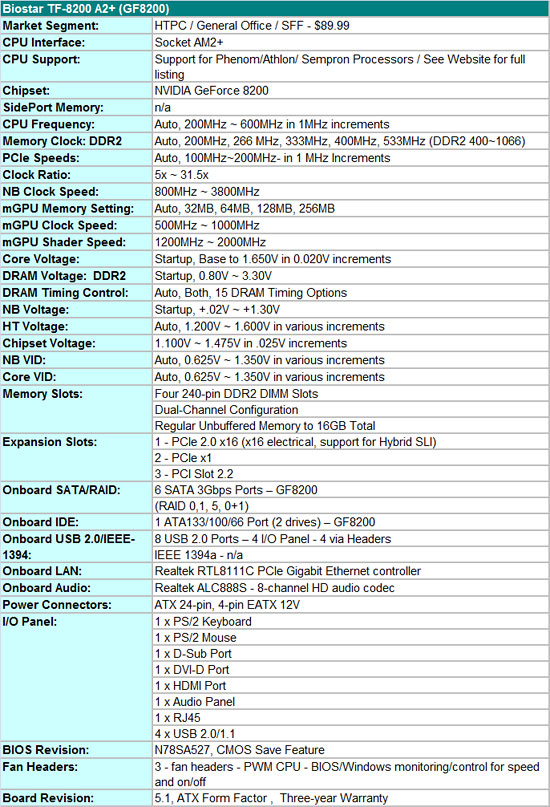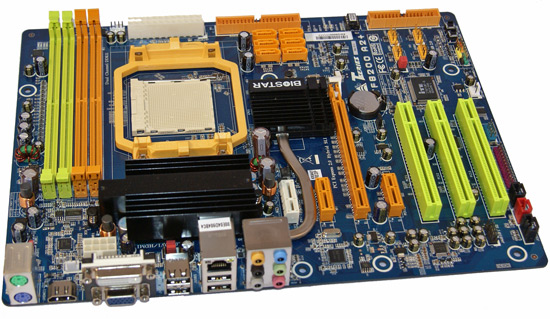The IGP Chronicles Part 2: AMD 780G vs. Intel G45 vs. NVIDIA GeForce 8200
by Gary Key on October 14, 2008 12:40 PM EST- Posted in
- Motherboards
The Motherboards
We've got a quick spotlight here on the boards we used to represent the AMD and NVIDIA chipsets included in this article.
NVIDIA GeForce 8200 from Biostar
Representing the GF8200 product family today is the Biostar TF-8200 A2+, which is part of Biostar’s T-Series family that offers a blend of performance features at a near value price point. This board features an ATX layout, support for NVIDIA Hybrid SLI, a feature rich BIOS, and a price of $89.99. Major competitors in the GF8200 arena include the ASUS M3N78-VM HDMI, MSI K9N2GM-FD, ECS GF8200A, and Zotac GF8200.

The TF-8200 A2+ is a feature rich GF8200 board with an OC friendly BIOS, Gigabit LAN via the almost universal Realtek RTL8111C, full RAID support along with six SATA ports via the GF8200, PATA support from the GF8200, and HD audio via the Realtek ALC888S. One interesting fact about SATA support from the GF8200/8300 series is that ports five and six only support AHCI or RAID mode; otherwise you are limited to four SATA ports.

In our opinion, Biostar provided an excellent layout with an old school AMD memory slot configuration. When utilizing a dual slot video card, the user is still left with with two free PCIe x1 and three PCI slots. The chipset heatsink designs did not interfere with a variety of peripherals that we installed including several popular heatsinks and video cards. Our only complaint would be the GF8200 runs slightly hot under load so we recommend active cooling (case fan or radial CPU fan design) in order to keep the chipset and PWM components cool.
Biostar utilizes an excellent 4-phase power delivery system along with quality capacitors throughout the board that resulted in very stable operation with everything from a 9950BE down to a BE-2400. The inclusion of PS/2 ports for a keyboard or mouse is a nice touch as is output support for VGA, HDMI, or DVI-D along with power and restart buttons. DVI-D support is limited to single link, so 1920x1200 is going to be the maximum desktop resolution. This is a limitation of the NVIDIA GF8200 chipset.
Pros/Cons
We had an interesting time with this board. Up until the latest NVIDIA platform and driver set, our interest in the GF8200 has never been that great. Besides the exclusion of a 5.1 channel HDMI audio setting, things are finally looking up for this chipset. As such, our opinion of the board changed slightly.
All of our AMD based boards today were limited in overclocking to around 250HTT with integrated graphics enabled. We were able to run the GPU shader clock to 1650MHz and the mGPU core clock to 630MHz. Increasing the core clock provided very little benefit, and increasing the shader clocks raised performance anywhere from 2% to 4% on average.
The Biostar board was extremely stable when clocking our 9950BE up to 234HTT, 8750 at 240HTT, and the 4850e at 245HTT with base memory clock set to DDR2-800 with 5-4-4-15 settings. We will delve into additional overclocking with our discrete GPUs shortly, but for those needing a IGP solution with overclocking, this board is recommended.
We had a couple of minor problems that a BIOS update should cure. The keyboard is not available after drive recognition until the Windows startup routine and HTT clocking with the 9350e was difficult. In addition, HDMI video out no longer works with the latest PowerDVD 8 Ultra update 2021a and the 178.13 driver set on this board. Either the EDID information or AACS key update is creating a conflict with the current BIOS. We rolled back to an earlier version and all was fine again for BD playback. Overall, this board did not inspire us but neither did it create any negative feelings during use. Biostar has provided a solid board with a very good feature set that we find hard to fault.














41 Comments
View All Comments
sergev - Monday, January 12, 2009 - link
A fair comparison? Don't think so! A AMD processor with a 140 Watt TDP and a Intel processor with a 95 Watt TDP?? I wonder why the intel chipsets seem more power efficient? If you are testing the performance, ok seems fair, but power efficiency should be measured with two processors with the same TDP. I am convinced that if you did the same test with a AMD 4850E the AMD would beat the crap out the intel versions on power consumption. But yet again, that would not be fair. So keep in mind that this review is not to be taken al to seriously!axiomhk - Tuesday, October 28, 2008 - link
Hi, what amazes me is that it seems no reviewers of the AMD IGP chipsets have caught the serious 2D issues referred to here:http://forums.amd.com/game/messageview.cfm?catid=2...">http://forums.amd.com/game/messageview....9&th...
However, the only channel that we consumers / mere mortals have to put pressure on AMD is to send feedback to the Catalyst team. Nothing seems to get done and there is not even any acknowledgement that this issue exists across the HD3200/HD3300 IGPs no matter which manufacturer.
The 3D performance is hyped up and that's all very well when the chipset has shown that it can deliver, but in fact many users will spend a lot of time on 2D activities which truly suck. This makes a lot of users regret their purchase.
What the renowned sites such as anandtech and tomshardware can do is try to reproduce the issues, then use their direct contacts to try to see if this issue is being addressed and update the parent article accordingly. Is it possible? Many thanks. GM - Hong Kong.
Zap - Wednesday, October 15, 2008 - link
"The keyboard is not available after drive recognition until the Windows startup routine"Try a different keyboard, or a PS/2 keyboard. I had the same problem with two MSI 750a boards and some Razer USB keyboards. No keyboard until Windows. I had to fix a BIOS problem and had to borrow a keyboard - Logitech G15 USB keyboard worked fine.
arjunp2085 - Wednesday, October 15, 2008 - link
Is this not a bit ODD to Compare a $260 to a Lowly Under performing [B}$173 CPU... Geezs This is Grossly inaccurateThink about the BOOST to Post Processing and It differs a Whole Lot to the Post processing capability
Strid - Wednesday, October 15, 2008 - link
Yeah, it would have made more sense, IMO, to use lower end processors like AMD 4850E or Intel E5200/7200 which is what most people would use in a HTPC.But if you want to do encoding on your HTPC also, I can see the need for a quad core. But not for your average "movie box".
Staples - Tuesday, October 14, 2008 - link
Really, this thing came out like 6 months ago it seems and finally we get some video benchmarks on anandtech. I know it has been commented that it did not work right for months because the video drivers were terrible but I can not believe it really took that long. When I had to get a HTPC, I just bought an Athlon BE and a 780G board. Much cheaper and adequate. Which in hindsight the P45 may have performed better, an Intel CPU and a Core 2 CPU would have driven the price up quite a bit.Kreed - Tuesday, October 14, 2008 - link
Gary, what are you hinting at with the following statement?"That leaves the Intel G45. If you are an Intel fan, this is your only real IGP choice... for the next few days at least."
Are you suggesting that Intel might be releasing a new IGP over the
Kreed - Tuesday, October 14, 2008 - link
Oops, i didn't get to finish the comment. Here's the comment in full:Gary, what are you hinting at with the following statement?
"That leaves the Intel G45. If you are an Intel fan, this is your only real IGP choice... for the next few days at least."
Are you suggesting that Intel might be releasing a new IGP over the next few days?
Strid - Wednesday, October 15, 2008 - link
The NVIDIA MCP7A (GeForce 9300/9400 IGP) boards supposedly launches today. They're sockey 775 boards. I'm pretty sure AnandTech will have a review up soon.http://www.silentpcreview.com/forums/viewtopic.php...">http://www.silentpcreview.com/forums/viewtopic.php...
GPGPUman - Tuesday, October 14, 2008 - link
AMD 780G and 790GX have 8 stream processors (5-way) for a total of 40 possible ops per clock... NOT 10